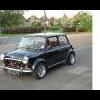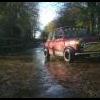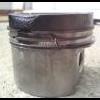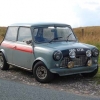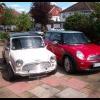I'm no automotive engineer...
The brace bars are just supposed to hold the shell to the subby in place of the front mountings and inner wings. On the pre 76 Minis, with subframe bolted directlly to the car, many didn't bother with any bracing and they passed MoT's.
I did once run a flip fronted Mini into the back of a Fiesta at 40mph (less a bit of heavy braking and skidding). The Fiesta ended up shorter than the Mini and I walked away unharmed. The front end fitted on the back seat in about a dozen pieces and the subframe towers were about an inch further back than before, after the engine had a go at knocking the bulkhead back. If I were to build another, I'd look at making the rear latch on to the A panel much more substantial (mine was a step up from rubber hooks with a reasonable locating tab and Dzuz fasteners). I might also add a fairly lightweight frame to locate in the bonnet landing panel area as the bumper section of my front was still attached to my subframe though the rest had ripped off between the corners off the grill aperture and the wheel arches.
Some of the Fibreglass shells with removable fronts look well thought out as the fronts look like they butt on to the flitch panel.
From what I've read, fibreglass is worse than steel in low speed accidents, but there's little difference at high(er) speeds.
Fibreglass survives low speed bumps better because it deforms elastically and will just bounce back, with maybe some crazed gel coat. Of course, that doesn't mean any passengers will have an easier time of it; but that would be down to design as much as materials. As Fibreglass, and more exotic composites, have a better strength to weight ratio there'd be more scope for building a safer structure without tipping the scales in main battle tank territory






